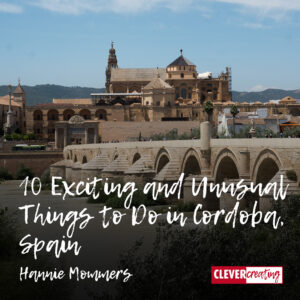
Córdoba is about a 4-hour drive from our house if we go in a straight line. There are enough exciting things to do in Cordoba. However, the last time we visited, it took us a week to get there because we first visited several other places.
Including the village of María which has a beautiful botanical garden situated on the slope of a mountain. We also stayed at a campground in the middle of the Cazorla National Park. And visited the beautiful excavations of Cástulo in Linares. I’ll write more about that in another article.
We enjoy this way of travelling so much, getting from one place to another at our leisure and seeing both known and unknown places. I can highly recommend the alternation of camping cabin and hotel stay that we have done.
Some of the links are affiliate links. As an affiliate associate, I earn a small commission when you purchase any of the products offered through the shared links at no extra cost to you. This helps me to maintain this website and I thank you for supporting me.
Table of Contents
The imperfection of my Art History study
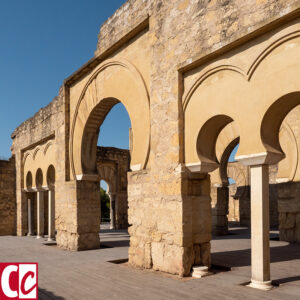
It wasn’t until we visited Andalucía in 2003 that I discovered a big shortage in my Art History lessons at the Arts Academy.
The curriculum covered a period from the Classics through the Early Christian era to Renaissance, Baroque and Modern times.
Absolutely nothing about Islamic culture, nor that the Moors had conquered a part of Europe and left their mark there. In Córdoba and Granada, we noticed what beautiful traces they left.
Between the 8th and 15th centuries, the Christians did their utmost to reclaim their lost territory in Spain during the Reconquista. Something by the way that is still celebrated annually in many cities and villages throughout the country: the festivals of Moros y Cristianos.
Religious tolerance
Near Ground Zero in New York City an Islamic community centre and mosque was planned, which originally was going to be called the Cordoba House. The developers hoped to promote an interfaith dialogue within the greater community.
Córdoba applies as an example of religious liberty and tolerance due to the relative freedom that Christians and Jews enjoyed during the city’s Islamic Caliphate in the 9th and 10th centuries. The name Cordoba House is changed to Park51 because of all the objections to a mosque this close to Ground Zero. As far as I know, the project is still in the planning phase.

During two centuries Christians and Jews could indeed practice their faith under the Caliphate of Córdoba. Although this right had to be bought. All “unbelieving” men paid an amount of tax by which they essentially acknowledged their submission to the state.
Apparently, the coexistence of faith was never self-evident, neither today nor in the Middle Ages. In 1011, the Jewish minority in Córdoba was struck by an Islamic pogrom.
Exciting things to do in Córdoba
It’s easy to spend several days in Córdoba. The city is interesting and fizzing with energy. It is also the warmest city in Europe, so if you can’t stand temperatures above 35 degrees C and even 40C you’d better plan well.
May is a great time to visit because of the Fiesta de Los Patios. Several courtyards are then open for 2 weeks for the public to admire their beautiful plants. This annual festival is on the UNESCO World Heritage Site, as is the historic centre of the city.
In the present time, Córdoba is the 3rd largest city of Andalucia, but once it was one of the most important cities in the world, even the second largest in the 10th century, with about 500.000 people living there.
During this golden age, the economy, science and culture flourished. The city was teeming with libraries, the largest containing about 600.000 books.
The city is also the birthplace of philosophers such as Seneca, Averroes and Maimonides.
The Mezquita
Mezquita is the Spanish word for mosque. The first time we were visiting Córdoba we were in a hotel right across the entrance of the Mezquita.
Nowadays almost every city of importance is complaining about the horde of tourists, back then there were less and the city centre was even accessible by car.
Entering the Mezquita the first impression is overwhelming. Especially when you realize that the oldest parts are over 1.000 years old.
I remember our horror when we heard a Catholic Mass recited loudly through the speakers. It was so out of place with the dark, dimly lit Islamic columns.
Very ungrateful of us, because the mass was also the reason that we could visit the building for free. And now that we know more about the history of Córdoba, we understand the development of sacred buildings.
Originally there was a Roman temple on this site, over which a Christian church was built. Then the Moors built their mosque on the remains of that church, after which the Christians erected their cathedral in the middle of the mosque.
Personally, I find the latter addition ugly from an aesthetic point of view. There is quite a contrast between the old Islamic parts and the later Christian ones. The building shows traces of Moorish, Roman, Byzantine, Syrian, Persian, Gothic, Renaissance and Baroque elements, making it a must-see.
The old Synagogue

In the former Jewish quarter, called the Judería you can find the old synagogue, one of the few remaining Spanish synagogues. In 1492 the New World started in the history books with the discovery of America by Columbus, but for the Jews, this signalled the turn of a black page in their history, characterized by persecution and exile.
The Alcázar de Los Reyes Católicos
Close by the Mezquita is an Alcázar, a Moorish castle turned into a Christian one after the Reconquista. This Castle of the Catholic Kings is a medieval one with beautiful gardens and attractive fishponds. In the cellars are old Arabic baths to be seen.
Los Reyes Católicos of Spain are Isabella I of Castile and Ferdinand II of Aragon, the kings who sent Columbus on his journey. The Alcázar was one of their palaces.
Baños del Alcázar Califal
These baths or hammams are wonderful to visit. A series of stone-walled rooms with red and black marble columns, crowned by beige capitals. The characteristic star skylights are very special.
The washings and body cleansing were an essential part of Muslim life. They were required for prayer, in addition to forming a social rite.
Other places of interest
- The Puente Romano, a bridge over the Guadalquivir;
- Calleja de las Flores, one of the atmospheric streets;
- Torre de la Calahorra, a watchtower at the end of the Roman bridge.
Unusual things to do in Córdoba
While it is great to visit the usual sights, which are the usual places of interest for a reason, we always like to search for the less visited places.
Botanical gardens
This is a huge terrain not that far from the old city centre. Like most botanical gardens it has several departments with plants from all over the world. And a couple of buildings with exhibitions about Spanish and worldwide botanical subjects.
Centro de Arte Contemporáneo C3A
A true surprise was the Modern Art Center C3A. The full name is Centro de Creación Contemporánea de Andalucía. It’s situated on the other side of the river.
What I loved most were the workplaces for the artists in residence. Not because we could visit them, unfortunately, but because of the fact that they were there.
The rest of the building is free to visit. The exhibitions are partly permanent, like the blue staircase of Yoko Ono, and partly temporary. We spent a pleasant afternoon there.
Madinat al-Zahra
About 10 km from the city are the ruins of Medina Azahara, built as a palace city in the 10th century. The ruins stretch on the naturally terraced slope of an offshoot of the Sierra Morena. It seems the palace city did not last long. Just a few years after its termination, rebel Berber forces destroyed this symbol of the Caliphate of Córdoba.
Much of it has still not been excavated, so this must have been a huge complex. The first time we visited we could park nearby and visit Madinat al-Zahra as an EU resident for free.
Because the nuisance of the cars became too great, there is now a visitor centre from which a bus runs to the entrance of the excavation site. From there you can wander around the beautiful ruins by yourself or with a guide. An explanatory 3D reconstruction is shown in a cinema in the visitor centre.
Some final tips
Assuming you have no difficulty walking, look for a hotel on the other side of the river. Here you will also find several cafes and restaurants that offer tasty Spanish food for a reasonable price and with a view of the river and the old city.
If you can be in the city centre early, go to the Mezquita between 8:30 am and 9:30 am. From Monday to Saturday, it is accessible for free, provided you are very quiet.
Spanish monuments often have a discounted entrance fee for people over 65, if you can identify yourself with a passport or driver’s license.
Plan your indoor activities in the afternoons, especially in the warm months! In Spanish summers, the hottest time of the day is between 3 pm and 6 pm.
Have you ever visited Andalusia? Tell us in the comment box below.


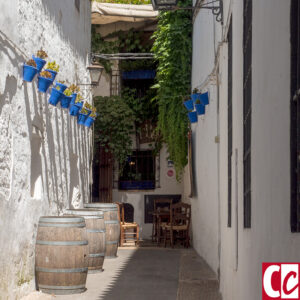
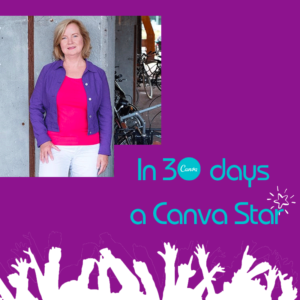
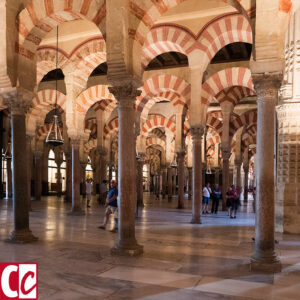
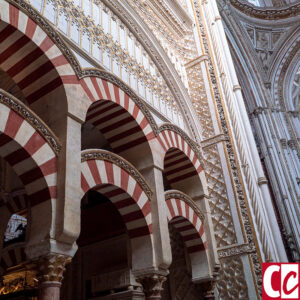
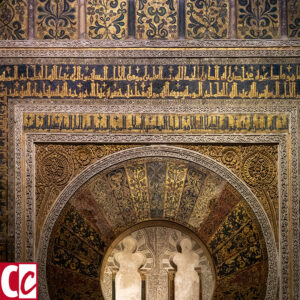
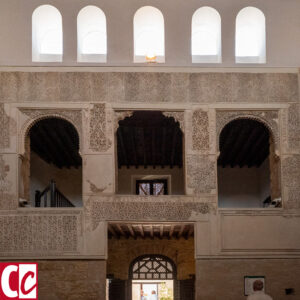


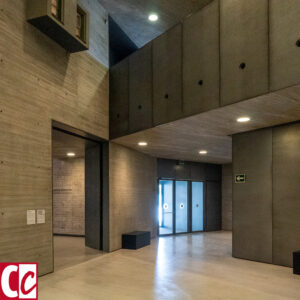

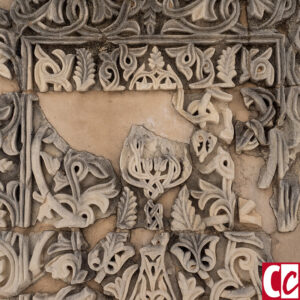
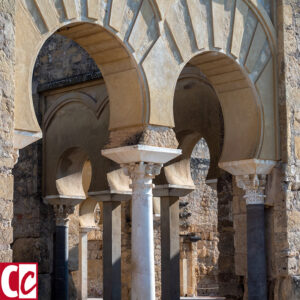
I reserved to go on a trip to Spain last summer. I couldn’t go because of this covid-19 crisis. And now I’m reading your article so I can prepare even better for the next time. I’ll have to visit The Alcázar de Los Reyes Católicos, to see that garden, and to pray to God a bit.
Just a question, what do you think – should I make a reservation to some hotel, or Airbnb is a better choice?
Thanks for the in-depth article 🙂
What a pity, Petar, you had to cancel your trip. I am having a hard time occasionally by not being able to go anywhere, but I would even feel more horrible if I had booked and all. The only consolation is, we’re all on this together. Nothing to be done about it at the moment.
A friend had a horrible experience booking an Airbnb location in Madrid. Yet, another friend loves booking there, because he has been to the Costa Brava and Valencia several times and had very good experiences. As I have never booked at Airbnb myself yet, I couldn’t recommend which option is best.
We even hardly ever book way in advance for a hotel, because we don’t like obligations. So either we book while driving in the direction of a town or we go directly to a hotel and ask for the prices. Sometimes it’s cheaper at the counter, sometimes it’s cheaper on the internet. In the latter case, we step aside and tell them we’ll be back later. We’ll sit in the hall and book on the internet. Easy peasy. 😉
Spain sure seems like a long ways from my home! Although for you a 4 hour drive is reasonable.
Apparently I need to travel much further away from home if I want to see things built 1000 years ago, in my area a city 200 or 300 years is considered old.
They sure must have built the buildings strong and correctly if they are still standing after all that time.
You say the temperature can be around 100 degrees fahrenheit. How is the humidity there? We have high summertime temperatures in the mid to high 90’s along with high humidity making it feel much hotter!
Which motel would you recommend nearby the ruins of Medina Azahara?
Hi Justin. I guess you are from the States? They are huge so I can imagine you have to travel far, yet I have seen beautiful ancient buildings over there when I visited Utah, Arizona and Nevada. Every country has its own history. I love to dive into that and explore the remains.
Here in Europe lots of remains are even older than a 1000 years. Like the Greek and Roman buildings and ruins that are 2000 years and over. And I agree with you they sure knew back then to build strong. The funny things is that they found out what was the correct way during the process. Hence several of leaning towers of which the foundations were not too clever after all. 🙂
I don’t know the numbers for the humidity, but since I am Dutch I do know the Spanish temperatures are better to endure than those of the Netherlands, where it is often very humid. Spanish summers are dry. I am not as resistant to high temperatures as my husband, but still find the heat more tolerable here in Spain.
There isn’t a motel near Azahara, the place is in a quite deserted area. Even the highway is not close by. But since it is just about 10km (6 miles) from the center of Córdoba it is easy to find sufficient accommodation nearby.
Wow, what great information! You pointed out so many things to do, I feel I don’t need to go! LOL! I haven’t even been overseas, let alone Spain, but it looks like a fascinating place with intricate history. You chose wonderful photos to entice us with. Though it’s a 4 hour drive for you, do you visit often? Thanks for a great tour here!
Thanks, Yvette. Well, I wish I could visit often, but for the past year we were hardly allowed to drive. We haven’t been living in Spain for a long time yet. So some of my pictures are from the time we still lived in the Netherlands. But as soon as traveling is allowed again we will be going into that direction as there are such a lot of other places of interest in the neighborhood of Córdoba as well. I love that area.
LOL, yes, I know the feeling. If you see beautiful pictures or a film of a place it almost is as if you are there. Yet the feeling of wandering around in a place yourself is a totally different experience than only looking at it. Especially in the Mezquita. The pictures look quite light, but that is a trick of the camera. In reality the place almost looks dark when you enter and it is such an impressive atmosphere that instantly makes you turn quiet.
Hi there Hannie,
This is a great list of ideas of things to do and places to visit during a trip to Cordoba, Spain. While I’ve never been to Spain or anywhere in Europe for that matter, your mention of art history piqued my interest. I was also an art major (Graphic Design to be specific) and I always really enjoyed my art history classes, even though there was way more writing than my other art classes. I’ve always wanted to travel the world to see various famous works and landmarks.
I also found it very interesting the connection you made to Ground Zero in NYC and Cordoba. It seems though that there isn’t really a parallel beyond the original name for the Ground Zero location for religious tolerance was named after Cordoba, but then changed after the incidents in 1011 (also curious if you meant 2011 or 1011 – thats a long time back!)
If (and when) I visit Spain, I will be sure to reference this list, as it is awesome and very helpful.
Thanks, Dev. Thanks for reminding me I have to be clear in my explanations. I am going to adjust my text, because at the moment it really is looking like I made a typo in the year. I didn’t. It really is 1011, but it is referring to Córdoba, not to Ground Zero. And yes, it sure is a long time back, but repression is unfortuantely of all ages.
That is so cool you were majoring in Graphic Design. So was I! 🙂 I have loved my art history lessons as well. The lack in explaining about other cultures is something I filled in myself later on. My teachers all were very passionate about their subjects. Which is marvelous, because as a student one gets very inspired by passionate teachers, don’t you think?